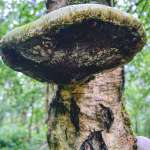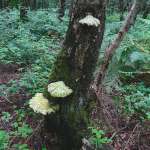Birch Polypore - Fomitopsis betulina
At A Glance:
Birch Polypore - Fomitopsis betulina
Other names: Razor Strop Fungus, Piptoporus betulinus, Boletus suberosus
Season: Summer, Autumn
Edibility: Edible, Medicinal
Fungi Type: Fungi With Pores, Saprobic, Parasitic
Frequency: Very Common
Habitat: Deciduous woodland
Average width and height: w: 10 - 300mm h: 20 - 100mm
Key Features:
- Grows on birch
- Off-white to buff colour
- Smooth surface
- White to off-white underneath
- Grows horizontal
The Birch Polypore is one of my all time favourites. It has an incredibly rich and fascinating history, very beneficial medicinal properties and an array of uses. The ongoing research makes for interesting reading!
Table of Contents
Habitat/Season
Habitat: Deciduous woodland and almost anywhere where birch trees are.
Season: Jul, Aug, Sep, Oct, Nov
As the name implies, these grow almost exclusively on on birch. They are parasitic and saprobic, so are most commonly found on dying or dead birch trees.
Whilst these can be found all year round, they have a annual growth cycle starting in summer and continuing through until late autumn. After their season, these toughen up and begin decaying. You can often see several on one tree, and sometimes with the old decaying ones from last season. See the photos!
Cap/Flesh/Fruiting Body
Average size: 10 - 300mm
Shape: ovoid, flat
Colour: off-white, light grey, browning, white underneath
The size can vary greatly, as seen in the featured image (this one measured about 30cm across!), but almost always starts very spherical and small, like a ’nub’, before maturing and flattening out. The top surface is smooth, off-white to light grey before browning a little with age, and the underside is white. The old specimens will become discoloured with all sorts and the underside will look rotten - because it is.
When cut, the flesh is white and dense, and the surface ‘skin’ can be peeled away.
Pores/Spore
Density: dense
Colour: white
Spore print: white
Spore shape: ellipsoidal, smooth
The underside is white and contains very densely packed tubes - the pores are visible only right up close. The tubes often turn a buff shade when older.
Possible Confusions
This species is in my list of top fungi for beginners because it is very easy to identify.
Edibility/Taste/Smell
These smell lovely and mushroomy, and are an edible species. The flavour has a bitterness to it and is better used dried and powdered. I’ve found the bitterness varies between each one, so I always taste a little of it after drying and before blitzing.
Medicinal Uses
There’s an awful lot of facts and info to go through and reference - stay tuned.
Notes
Etymology: Previously called Piptoporus betulinus., pipt = to fall, porus = pores, betulinus = ‘of birch trees’
Once used to strop barbers razors. As someone who believes a sharp knife is a safe knife, I can confirm using this to strop a blade really is effective.
Ötzi the Iceman - two pieces found with him. Believed to have been used for it’s medicinal properties.
References
Mushrooms and other fungi of Great Britain & Europe - Roger Phillips
Mushrooms and Toadstools of Britain and Ireland - Blacks Nature Guides

















